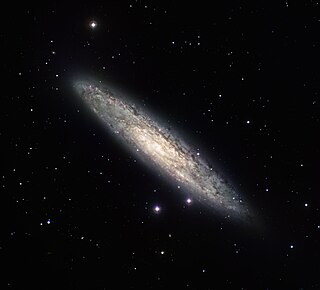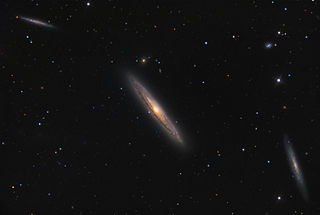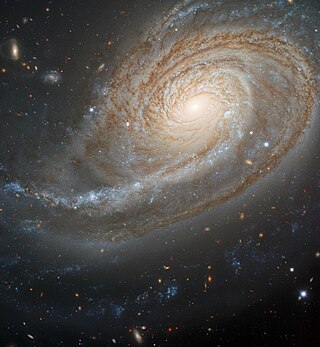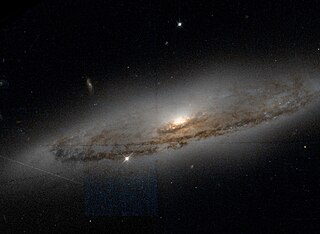
An elliptical galaxy is a type of galaxy with an approximately ellipsoidal shape and a smooth, nearly featureless image. They are one of the three main classes of galaxy described by Edwin Hubble in his Hubble sequence and 1936 work The Realm of the Nebulae, along with spiral and lenticular galaxies. Elliptical (E) galaxies are, together with lenticular galaxies (S0) with their large-scale disks, and ES galaxies with their intermediate scale disks, a subset of the "early-type" galaxy population.

NGC 404 is a field galaxy located about 10 million light years away in the constellation Andromeda. It was discovered by William Herschel in 1784, and is visible through small telescopes. NGC 404 lies just beyond the Local Group and does not appear gravitationally bound to it. It is located within 7 arc-minutes of second magnitude star Mirach, making it a difficult target to observe or photograph and granting it the nickname "Mirach's Ghost".

A dwarf galaxy is a small galaxy composed of about 1000 up to several billion stars, as compared to the Milky Way's 200–400 billion stars. The Large Magellanic Cloud, which closely orbits the Milky Way and contains over 30 billion stars, is sometimes classified as a dwarf galaxy; others consider it a full-fledged galaxy. Dwarf galaxies' formation and activity are thought to be heavily influenced by interactions with larger galaxies. Astronomers identify numerous types of dwarf galaxies, based on their shape and composition.

NGC 2403 is an intermediate spiral galaxy in the constellation Camelopardalis. It is an outlying member of the M81 Group, and is approximately 8 million light-years distant. It bears a similarity to M33, being about 50,000 light years in diameter and containing numerous star-forming H II regions. The northern spiral arm connects it to the star forming region NGC 2404. NGC 2403 can be observed using 10×50 binoculars. NGC 2404 is 940 light-years in diameter, making it one of the largest known H II regions. This H II region represents striking similarity with NGC 604 in M33, both in size and location in galaxy.

Messier 110, or M110, also known as NGC 205, is a dwarf elliptical galaxy that is a satellite of the Andromeda Galaxy in the Local Group.

The Sculptor Galaxy is an intermediate spiral galaxy in the constellation Sculptor. The Sculptor Galaxy is a starburst galaxy, which means that it is currently undergoing a period of intense star formation.

NGC 4395 is a nearby low surface brightness spiral galaxy located about 14 million light-years from Earth in the constellation Canes Venatici. The nucleus of NGC 4395 is active and the galaxy is classified as a Seyfert Type I known for its very low-mass supermassive black hole.

NGC 1569 is a dwarf irregular galaxy in Camelopardalis. The galaxy is relatively nearby and consequently, the Hubble Space Telescope can easily resolve the stars within the galaxy. The distance to the galaxy was previously believed to be only 2.4 Mpc. However, in 2008 scientists studying images from Hubble calculated the galaxy's distance at nearly 11 million light-years away, about 4 million light-years farther than previously thought, meaning it is a member of the IC 342 group of galaxies.

NGC 1532, also known as Haley's Coronet, is an edge-on barred spiral galaxy located approximately 50 million light-years from the Solar System in the constellation Eridanus. The galaxy was discovered by James Dunlop on 29 October 1826.

NGC 1531 is a dwarf galaxy in the constellation Eridanus that is interacting with the larger spiral galaxy NGC 1532. It was discovered by John Herschel on 19 October 1835. Although technically classified as a peculiar lenticular galaxy, the galaxy's structure is better described as amorphous.

NGC 4216 is a metal-rich intermediate spiral galaxy located not far from the center of the Virgo Cluster of galaxies, roughly 55 million light-years away. It is seen nearly edge-on.

NGC 772 is a large unbarred spiral galaxy approximately 106 million light-years away in the constellation Aries. It was discovered on 29 November 1785 by German-British astronomer William Herschel.

NGC 1232, also known as the Eye of God Galaxy is an intermediate spiral galaxy about 60 million light-years away in the constellation Eridanus. It was discovered by German-British astronomer William Herschel on 20 October 1784.

NGC 4845 is a spiral galaxy located in the constellation Virgo around 65 million light years away. The galaxy was originally discovered by William Herschel in 1786. It is a member of the NGC 4753 Group of galaxies, which is a member of the Virgo II Groups, a series of galaxies and galaxy clusters strung out from the southern edge of the Virgo Supercluster.

NGC 428 is a barred spiral galaxy in the constellation of Cetus, with its spiral structure distorted and warped, possibly the result of the collision of two galaxies. There appears to be a substantial amount of star formation occurring within NGC 428 and it lacks well defined arms — a telltale sign of a galaxy merger. In 2015 the Hubble Space Telescope made a close-up shot of the galaxy with its Advanced Camera for Surveys and its Wide Field and Planetary Camera 2. The structure of NGC 428 has been compared to NGC 5645.

NGC 5634 is a globular cluster in the constellation Virgo (constellation), located about 82,200 light years away. NGC 5634 has an apparent magnitude of about 10 and a diameter of 4 or 5 arcminutes. Its Shapley–Sawyer Concentration Class is IV, meaning the cluster shows intermediate rich concentrations. The star near the upper right is the eleventh-magnitude UCAC2 29844847. There is also a bright orange giant, HD 127119, about 1.3 arcminutes away from the cluster.

Bedin I is a dwarf spheroidal galaxy located in the constellation Pavo. It is situated around 28.38 million light-years from Earth, behind the globular cluster NGC 6752. Bedin I is possibly one of the oldest galaxies known, having formed around 10–13 billion years ago, and is one of the most isolated dwarf galaxies known, situated around 2.12 million light-years away from NGC 6744, its nearest neighbor with which it may be physically associated. As such, it has been deemed by astronomers as a "fossil" from the early universe. It was accidentally discovered by Italian astronomer Luigi Bedin, whose team was studying white dwarfs in NGC 6752 using the Hubble Space Telescope in September 2018; the discovery was announced in a paper published in January 2019.

Donatiello I, also known as Mirach's Goblin, is a dwarf spheroidal galaxy in the constellation Andromeda, located between 8.1 and 11.4 million light-years from Earth. It is a possible satellite galaxy of the dwarf lenticular galaxy NGC 404, "Mirach's Ghost", which is situated 60 arcminutes away. It is otherwise one of the most isolated dwarf spheroidal galaxies known, being separated from NGC 404 by around 211,000 light-years. The galaxy is named after its discoverer, amateur astronomer and astrophotographer Giuseppe Donatiello, who sighted the galaxy in a 2016 review of his archival long exposures from 2010 and 2013. Follow-up observations with the Roque de los Muchachos Observatory led to a scientific paper on its discovery being published in December 2018.

NGC 4306 is a dwarf barred lenticular galaxy located about 100 million light-years away in the constellation Virgo. The galaxy was discovered by astronomer Heinrich d'Arrest on April 16, 1865. Although considered to be a member of the Virgo Cluster, its high radial velocity and similar distance as NGC 4305 suggest that NGC 4306 is a background galaxy. NGC 4306 is a companion of NGC 4305 and appears to be interacting with it.

UGC 8837 is a dwarf galaxy located in the constellation of Ursa Major, 24 million light years away from Earth. It is a member of the M101 Group, a group containing several galaxies orbiting the largest, the Pinwheel Galaxy (M101).



















